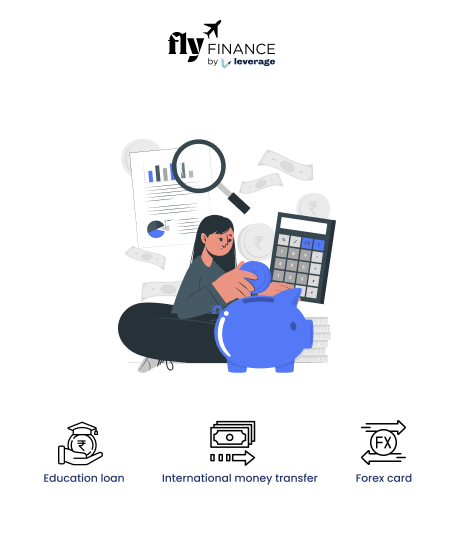Different Types of Bank Accounts in India: Smart money management begins with choosing the right bank account. Whether saving for a goal, handling everyday expenses, or dealing with international transactions, your choice matters.
There are different types of bank accounts in India, and each one serves a specific purpose. But if you pick the wrong one, you might pay hidden fees or miss out on benefits.
Wondering which account suits your needs? This guide breaks down the major types of bank accounts in India so you can make an informed choice and take control of your finances.
Table of contents
Savings Account
This is one of the most popular and basic types of bank accounts in India. It’s ideal for individuals who want to keep their money safe and earn interest. Most savings accounts offer 2.5% to 4% interest annually. However, some private banks offer more, usually up to 8% p.a.
A savings account suits almost everyone, including students, salaried employees, retirees, and even homemakers. It encourages saving and provides easy access to funds via ATMs, cheques, or UPI within cash withdrawal limits for savings accounts.
Leading banks like SBI, HDFC, ICICI, and Kotak Mahindra offer various types of savings accounts with features like zero balance, digital access, and cashback. You can open one online or by visiting a branch with basic KYC documents.
It is important to note that not all savings accounts are the same. Indian banks offer different types of savings accounts for specific needs. Here are two of the most popular ones-
Basic Savings Bank Deposit Account (BSBDA)
This is a government-backed account aimed at promoting financial inclusion. This is a type of savings account offered by banks in India that comes with no minimum balance requirement.
The BSBDA account is ideal for individuals with low or irregular income, rural citizens, and those opening their first bank account.
Key features include:
- No minimum balance requirement
- Free ATM card and basic online banking access
- Easy documentation—just an ID and address proof required
Banks like SBI and Union Bank of India offer this account. However, it is important to know BDBSA account limits and transaction restrictions to stay within the RBI guidelines.
You can explore the features, benefits, eligibility, documentation, and account opening process for the popular BSBDA accounts in India below.
| Axis Bank BSBDA Account | SBI BSBDA Account |
| ICICI BSBDA Account | HDFC BSBDA Small Savings Account |
| IndusInd BSBDA Account | PNB BSBDA Account |
Also Read: RBI Guidelines on Basic Savings Bank Deposit Account (BSBDA)
Zero Balance Savings Account
As the name implies, this account allows you to maintain zero balance without facing penalties. It functions just like a regular savings account but with greater flexibility.
Opening a zero-balance minor account online is also a straightforward process. All you need to do is fulfil the eligibility requirements and fill out the application form on the bank’s website. Submit the required documents and wait for the verification process.
These accounts are perfect for:
- Students, young professionals, and new account holders
- Those who want interest on deposits without worrying about minimum balance
- People looking for a fully digital account opening experience.
Popular banks with zero balance accounts in India offer various accounts like Kotak 811, SBI Insta Saving, and ICICI Bank’s zero balance account. You’ll need just your Aadhaar and PAN to get started.
Also Read: Union Bank of India Zero Balance Account Opening Online Process
Current Account
Current accounts are another type of bank account in India that are meant for businesses. These accounts support large volumes of transactions and provide unlimited withdrawals. However, most banks set daily current account withdrawal limits between INR 50,000 to 1 lakh.
If you run a business or need to make frequent payments, this is the account for you. You’ll find tailored current account solutions with banks like Axis Bank, Yes Bank, and ICICI Bank.
Opening a current account usually requires business-related documents like GST registration and PAN, along with your ID and business address.
Current accounts don’t offer interest, but they offer other features that are highly valuable to keep your business running:
- Overdraft facilities (based on bank’s discretion)
- High transaction limits
- Multi-city cheque facility
- Dedicated relationship managers (in premium variants)
- Bulk payment features like salary disbursement, vendor payments, etc.
One important feature is that most banks require a higher average monthly balance (AMB), usually ranging from INR 10,000 to INR 1,00,000, depending on the account type and bank. Failing to maintain this can lead to non-maintenance charges.
Fixed Deposit Account
A Fixed Deposit Account is a type of bank account where you deposit a lump sum of money for a fixed period and earn interest on it. The amount stays locked in, and you get guaranteed returns, which are higher than a regular savings account.
Check out the key features below-
- Interest Rates: Generally between 5.5% to 7.75%
- No market risk – returns are fixed
- Loan facility: You can take a loan or overdraft against your FD
- Taxation: Interest earned is taxable, but exemptions apply if Form 15G/15H is submitted
Here’s how it works-
- Choose a tenure—from 7 days to 10 years
- Interest is fixed and paid monthly, quarterly, or at maturity
- You can’t withdraw early without a penalty
FD accounts are offered by almost all major banks like SBI, HDFC, Axis, and IDFC FIRST.
Who Should Open an FD Account?
- People with surplus funds they don’t need immediately
- Students or parents looking to save securely for education
- Risk-averse investors wanting safe, fixed returns
- Retirees seeking regular income through interest payouts
The interesting part is that many banks let you get an education loan against a Fixed Deposit– a smart option for students with no credit history. You can borrow up to 90% of the FD amount, and the interest rate is usually lower.
FD account opening takes minutes. To start an FD and open a Fixed Deposit account, you need to log in to your bank’s app or net banking. You can also visit your bank branch.
Also Read: SBI Loan Against FD: Features, Eligibility, How to Apply
Recurring Deposit Account
If you don’t have a large sum to deposit at once, an RD is a smart choice. A Recurring Deposit Account allows you to deposit a fixed amount every month, and you earn interest similar to FDs.
RDs are great for students or salaried individuals who want to build a savings habit. You choose the deposit amount and the tenure, and the bank calculates interest accordingly.
Check out the key features below-
- Flexible tenures: usually from 6 months to 10 years
- Interest rates range from 5.5% to 7.5%, depending on the bank and tenure
- Interest is compounded quarterly and paid at maturity
- Ideal for building a disciplined saving habit
Unlike FDs, premature withdrawal in recurring deposit accounts is allowed but may come with a penalty. Also, if you miss a monthly deposit, a small fine is charged. To overcome this challenge, some banks allow auto-debit from your savings account.
Interest earned on an RD account is taxable. TDS may apply if the total interest exceeds INR 40,000/year (INR 50,000 for senior citizens).
You can now open RD accounts online via net banking or mobile apps. Some of the popular options to open a Recurring Deposit Account are:
- SBI Recurring Deposit
- Post Office RD (offers fixed 5-year term and government-backed safety)
- ICICI Flexi RD – allows flexible monthly deposit amounts
Check out a common query: Is RD Similar to SIP?
Well, at first glance, Recurring Deposits (RDs) and Systematic Investment Plans (SIPs) look similar. They both involve regular monthly investments. But they are quite different in terms of risk, returns, and purpose.
Let’s check out the similarities and differences between recurring deposits and SIPs.
Similarities
- You invest a fixed amount every month
- Both help build a disciplined saving habit
- Great for achieving short- to medium-term goals
Differences
| Feature | RD | SIP |
| Risk Level | No risk (bank-backed) | Market-linked (risky) |
| Returns | Fixed (5.5% to 7.5%) | Variable (8% to 15% or more) |
| Lock-in | Fixed tenure, early withdrawal penalty | Can be flexible, depending on the fund |
| Investment Type | Deposit in bank | Investment in mutual funds |
| Tax Benefits | No tax benefit | Tax-saving SIPs available (like ELSS) |
Which One Should You Choose?
- Go for an RD if you want guaranteed returns and zero risk.
- Choose an SIP if you’re comfortable with market risks and aiming for higher returns.
Salary Account
A Salary Account is a type of savings account designed for salaried employees. Your employer credits your monthly salary into this account. What makes it special? It usually comes with zero minimum balance, better perks, and exclusive offers.
Here are the key features of a salary account:
- Zero balance requirement
- Instant account opening when onboarded by the employer
- Free debit cards with airport lounge access, internet banking, mobile banking, and more
- Auto-convert to regular savings account if no salary is credited for 3 months (as per RBI norms)
Who Should Have It?
- Full-time employees with a steady salary
- Freshers starting their first job—great for managing income
- Companies offering bulk salary disbursal prefer this model for smooth payouts
Perks You Might Get:
- Higher ATM withdrawal limits
- Cashback on bill payments, food apps, or travel bookings
- Special loan offers like instant personal loans or credit cards
- Early salary credit with some fintech salary accounts (like Fi Money or Jupiter)
Some of the banks offering great salary accounts are:
- Axis Bank Prime Salary Account
- HDFC Classic Salary Account
- Kotak Edge or Platina Salary Accounts
- ICICI PayLater and Insta Save Salary Accounts
NRI Account (Non-Resident Indian)
Another type of bank account in India is the NRI account. If you’re an Indian living abroad (working, studying, or settled overseas), you might still need to manage money in India. You may have family here, property that earns rent, or just want to invest or save for the future.
To help you manage your finances smoothly and legally, Indian banks offer special accounts for NRIs (Non-Resident Indians). These are known as NRI bank accounts. You can easily invest and transfer funds, but under foreign exchange rules for NRIs.
There are three main types of NRI accounts:
- NRE (Non-Resident External) Account
- NRO (Non-Resident Ordinary) Account
- FCNR (Foreign Currency Non-Resident) Account
Let’s understand these different types of accounts in India by non-residents below.
NRE Account (Non-Resident External)
An NRE account is meant for NRIs who want to send money to India from abroad and manage it in Indian Rupees (INR). You can deposit only foreign currency into this account, like USD, GBP, EUR, or AED, and the bank converts it into INR.
The best part? The interest you earn is completely tax-free in India. Plus, both the money you deposit and the interest earned can be repatriated (transferred) back to your foreign account anytime without any restrictions.
This makes the NRE account ideal for:
- Indians working or living abroad who want to send money home
- People looking for tax-free savings in India
- NRIs who want to pay for family expenses, investments, or EMIs from abroad
You can open an NRE savings, fixed deposit, or current account, depending on your needs.
NRO Account (Non-Resident Ordinary)
Now, let’s say you’re an NRI who has income coming from India, for example, rent from a property, dividends from shares, or a pension. In that case, you need an NRO account.
This account is designed to hold income earned in India, and it lets you deposit Indian Rupees. You can also deposit foreign currency, but it will be converted to INR.
The key thing to know here is that the interest earned on an NRO account is taxable in India, and there are repatriation limits if you want to transfer funds for NRO accounts.
You can send money from this account abroad, but it’s capped at USD 1 million per financial year, and you’ll need to file Form 15CA and 15CB for approval.
This account is best for:
- NRIs who have Indian income sources
- People with properties, pensions, or businesses in India
- Those who need to pay bills or invest in India using Indian earnings
You can open an NRO savings, fixed deposit, or even a joint account with a resident Indian—something that isn’t allowed with NRE accounts.
FCNR Account (Foreign Currency Non-Resident)
An FCNR account is a bit different from NRE and NRO. It’s a fixed deposit account where you can keep your money in foreign currency like USD, EUR, GBP, etc., without converting it to INR.
The biggest advantage of an FCNR account is that it protects your money from exchange rate fluctuations. So, if you want to save in foreign currency and earn interest, this is your best option. Like NRE, the interest earned is tax-free in India and fully repatriable.
It’s perfect for:
- NRIs who want to save without losing value due to currency conversion
- People earning in foreign currency and planning long-term investments
- Students abroad who want to park surplus funds securely
FCNR accounts are only available as fixed deposits, and the minimum tenure is 1 year up to 5 years.
Also Read: FCNR vs NRE Accounts: Which Account is Best for NRIs in 2025?
Now that you know about the NRI account in India and its types, let’s explore some important details about these accounts.
What’s Common Among All These Accounts?
- All these accounts are only available to NRIs, PIOs (Persons of Indian Origin), or OCIs (Overseas Citizens of India).
- You need to submit your passport, visa/ residency proof, overseas address, and ID to open one.
- Most banks like SBI, HDFC, ICICI, Axis, and Kotak offer online application and even video KYC.
- You can access your NRI accounts from anywhere in the world using mobile banking and internet banking.
Taxation & Repatriation (Transfer) Details
- NRE and FCNR account interest is tax-free in India.
- NRO account interest is taxable, and banks deduct TDS (Tax Deducted at Source) at 30%.
- To avoid double taxation, India has DTAA agreements with many countries—you can file Form 10F and claim benefits.
Also, funds from NRE and FCNR accounts are freely repatriable, while NRO accounts have a limit of USD 1 million/ year and require documentation.
Which Account Should You Choose?
- Choose an NRE Account if you earn only abroad and want to send money to India.
- Choose an NRO Account if you have income in India, like rent or dividends.
- Choose an FCNR Account if you want to save in foreign currency and avoid INR conversion.
RFC Account (Resident Foreign Currency)
A Resident Foreign Currency (RFC) account is a type of bank account in India that helps you manage foreign currency income legally in India.
So basically, if you’re an NRI returning to India permanently, the Resident Foreign Currency (RFC) Account allows you to retain your foreign savings and earn interest while also converting them to INR when needed. The account can be held in major currencies like USD or GBP.
Leading Indian banks such as SBI, HDFC Bank, and ICICI Bank offer RFC accounts with savings and fixed deposit options.
You’ll usually need:
- Proof of your past NRI status
- Re-entry documents like a passport with an arrival stamp or visa cancellation
- A local Indian address for KYC
Always remember that-
- Interest earned in an RFC account is taxable in India once you become a resident (as per the Income Tax Act).
- Funds in RFC accounts are freely repatriable, so you can move money back abroad if needed in the future.
Here’s What Makes It Different from NRE/ NRO/ FCNR?
| Feature | RFC Account | NRE Account | NRO Account | FCNR Account |
| Resident Status | For returning residents (not NRIs) | For NRIs | For NRIs | For NRIs |
| Currency | Foreign currency | INR | INR | Foreign currency |
| Repatriation | Freely repatriable | Freely repatriable | Limited to $1 million/year | Freely repatriable |
| Taxation in India | Interest is taxable | Interest is tax-free | Interest is taxable | Interest is tax-free |
| Purpose | Preserve foreign funds after returning to India | Send foreign income to India | Manage Indian income | Save in foreign currency while abroad |
In Simple Terms:
- NRE/FCNR = For NRIs to send or save money in India (foreign income)
- NRO = For NRIs to manage income from India
- RFC = For ex-NRIs (now Indian residents) who want to retain their foreign funds legally
Senior Citizens Account
A Senior citizens’ account is a special savings account with deposit schemes for individuals aged 60 and above. These accounts are designed to provide retirees with financial stability post-retirement, with features tailored for ease, safety, and better returns.
Check out the key features of the Senior Citizen’s Account in India-
- Higher interest rates on savings and fixed deposits (0.25% to 0.75% more than standard rates)
- Quarterly or monthly interest payouts for better liquidity
- Priority service at branches and phone banking
- Free health checkups, insurance coverage, or special debit cards (varies by bank)
To open this account, senior citizens must submit certain documents. These include-
- Age proof (Aadhaar/PAN with DOB)
- Recent passport-sized photo
- PAN card and address proof
You can choose popular bank schemes like SBI Senior Citizens’ Savings Scheme (SCSS), ICICI Bank Golden Years FD, and HDFC Senior Citizen Care FD.
Some of the latest updates are mentioned below.
- The Senior Citizens’ Savings Scheme (SCSS) interest rate is currently 8.2% p.a. (Q1 FY 2025).
- The maximum investment limit increased to INR 30 lakh (earlier, it was INR 15 lakh).
- Tenure: 5 years, extendable by 3 more years.
PPF Account (Public Provident Fund)
The Public Provident Fund (PPF) Acount is one of the most trusted long-term savings options in India. It’s backed by the Government of India, which makes it risk-free and fully tax-exempt.
You can make a minimum yearly investment of INR 500 and a maximum investment of up to INR 1.5 lakhs per year. Deposits can be made in lump sum or monthly installments (up to 12 per year).
Check out the key features of the PPF Account in India.
- Current interest rate: 7.1% p.a. (compounded yearly)
- Lock-in period of 15 years (can be extended in blocks of 5 years)
- Tax benefits: Under Section 80C (up to INR 1.5 lakh) and no tax on interest earned
- Partial withdrawals allowed after the 7th financial year
- Loans available between the 3rd and 6th year
This type of bank account in India is best for salaried individuals or freelancers planning a tax-free retirement corpus or parents investing on behalf of minor children (1 PPF account per person only).
All major banks like SBI, HDFC, ICICI, and Bank of Baroda offer PPF account opening online via internet banking. Alternatively, you can opt for a Post Office PPF Account.
To sum up, understanding the different types of bank accounts in India empowers you to make informed financial decisions based on your goals and lifestyle.
Whether you’re a student, business owner, or investor, choosing the right account helps you manage your money efficiently and maximize your savings.
FAQs
The key types of bank accounts include Savings Account, Current Account, Fixed Deposit (FD), Recurring Deposit (RD), Salary Account, and NRI Accounts (NRE/NRO). Each serves a unique purpose, whether it’s for everyday savings, business use, or long-term investments.
A Salary Account is best suited for salaried people. For instance, HDFC Bank’s Salary Account offers zero balance maintenance, free debit card, and up to INR 1 crore accidental death cover. The interest rate ranges from 3% to 3.5% p.a. based on the account balance.
Savings accounts are designed for personal use and earn interest between 2.7% to 4% p.a., while current accounts are mainly used by businesses for frequent transactions and usually don’t offer interest. Savings accounts have lower balance requirements, whereas current accounts often include overdraft facilities.
Yes, individuals can open multiple accounts across different banks or within the same bank. For example, you can maintain a savings account in SBI and a salary account in ICICI Bank at the same time, as permitted by RBI.
A zero balance account, like the Basic Savings Bank Deposit Account (BSBDA), allows you to operate your account without maintaining a minimum balance. Popular examples include PMJDY accounts with RuPay cards and Kotak 811 Digital Accounts with 3.5% p.a. interest.
Yes, Fixed Deposits (FDs) are time deposit accounts where your money earns higher interest over a fixed term. For example, SBI offers up to 6.5% p.a. and ICICI Bank offers around 7% p.a. Senior citizens often receive an extra 0.25% to 0.50% interest.
An RD account lets you deposit a fixed sum every month and earn compound interest. It’s a great way to build disciplined savings. For instance, depositing INR 2,000 monthly at 6.5% p.a. for one year can give you approx. INR 25,500 at maturity.
Yes, as per RBI regulations, KYC is mandatory. You’ll need valid documents like Aadhaar, PAN, or Passport for identity proof, and utility bills or rent agreements for address proof.
Absolutely. Students can open savings or youth accounts with zero balance features. For example, SBI’s Student Account allows INR 5,000 ATM withdrawals, and Axis Bank offers Youth Accounts. Students need to submit ID proof like Aadhaar and a bonafide certificate or student ID.
Fixed Deposit accounts generally provide the highest returns, with banks like RBL offering up to 8% p.a. and YES Bank up to 7.75% p.a. In comparison, savings accounts offer 3%–7% p.a., depending on the bank and balance.
To learn more about bank accounts for students, the best education loans, forex, banking experience for global students, or international money transfers, reach out to our experts at 1800572126 to help ease your experience with studying abroad.
Follow Us on Social Media





























